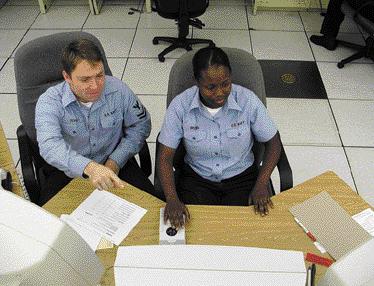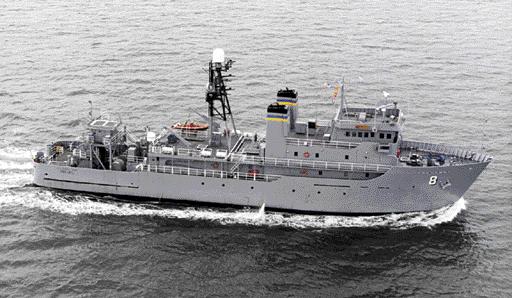
5 minute read
IUSS Shines in Smart Search 02
IUSS Shines in SMART SEARCH 0 2
by ENS Teddy G. Tan, USN
Advertisement
Undersea warfare is an important element in achieving Maritime Dominance, and this summer’s undersea warfare blockbuster was Smart Search 02. This coordinated, multi-platform exercise included participation by submarines, surface ships, and maritime patrol aircraft, with a featured role for the Integrated Undersea Surveillance System (IUSS).
Smart Search 02 took place over four days in mid-July off the eastern coast of the Carolinas. The exercise commenced with a simulated opposing f o rce (OPFOR) submarine coming from the n o rth to intercept a battle group transit and interdict a High Value Unit (HVU). The mission of the “Blue” force was two-fold – to locate and maintain track of the OPFOR submarine; and to ensure safe transit of the HVU through the battle group’s operating area (OPAREA) without being compromised.
Under the control of Commander Task Force 84, various task groups, units and elements were assembled to execute this highly complex, multiplatform exe rcise. Playing the OPFOR – or “Orange” – submarine was USS Augusta (SSN710) with appropriate acoustic augmentation. Blue theater assets included an IUSS team composed of two Su rveillance Towed Array Sonar Sy s t e m (SURTASS) ships – USNS Bold (T-AGOS-08) and USNS Pre va i l (T- AGOS-12), with embark e d military detachments (MILDETs), and the Naval Ocean Processing Facility (NOPF) Dam Neck in Virginia Beach, Virginia. Supplying land-based p a t rol aircraft we re Maritime Pa t rol and Reconnaissance Aircraft (MPRA) squadrons VP-5, VP-45 and VP-16 from Jacksonville, Florida and VP-26 from Brunswick, Maine.
Tactical prosecution of the Orange submarine was assigned to Commander Destroyer Squadron TWO under Commodore Daniel T h o m p s o n . Under Commodore Thompson we re three No rf o l k - based destroyers and a frigate: USS Porter (DDG78) as flagship, USS Arleigh Burke(DDG-51), USS Stump(DD-978) and USS Carr (FFG-52). Joining the DESRON from Mayport, Florida were U S S O’ Ba n n o n (DD-987) and USS Boone ( F F G - 2 8 ) , with helicopter detachments from HS-3 and HSL-42. USS Hyman G. Rickover (SSN-709) was the Blue force submarine, and the HVU role was played by USS Gunston Hall (LSD-44).
During the initial phase of the exercise, the Orange submarine transited from north to south into the battle group OPAREA as the HVU and her escorts tracked southwesterly, making maximum use of the environment to mask their noise. In these early stages, the theater-level IUSS team gained initial contact on the OPFOR submarine
At their consoles insi de Naval Ocean Processing Facility, Dam Neck, Virginia, Petty Officer 2nd Class Armin Schevey and Seaman Lacresha Brown keep track of the OPFOR submarine during Smart Search 02.

(left) USNS Prevail (T-AGOS-12)
(below) USS Hyman G. Rickover (SSN-709) served as the “Blue” force submarine in the exercise.
and provided valuable cueing while it was still days away from the battle g ro u p. The closing range enabled near-continuous tracking and localization for two days by NOPF and the two Su rveillance Towed Array Sensor Sy s t e m ( S U RTASS) ships and facilitated a “hot” turnove r to the DESRON as the submarine neared the battle group. At the start of the transition from theater to battle group prosecution, several explosive echo ranging (EER) events were staged by MPRA aircraft, and the resulting echo returns were detected by SURTASS and processed to fix the Orange position. Subsequently, the OPFOR submarine passed right between the two SURTASS ships. Once the tactical prosecution phase started, both SURTASS ships and all MPRA aircraft were “chopped” to the DESRON.
“IUSS performance was particularly impressive,” commented Commodore Thompson. “The long-range detections and accurate classification provided by Bold and Prevail – and corroborated by fixed-array data processed by NOPF – enabled rapid localization by [our] precursor forces.”
During the next two days, the Orange submarine was tracked and hunted relentlessly by Blue’s air, surface, and subsurface units. Simultaneously, the HVU made a successful transit of the OPAREA without being detected.
This success was achieved so early in the exercise that the scenario was “reset” and a second round of the cat-and-mouse game was played. C o m m o d o re Thompson organized another multi-platform prosecution of the Orange submarine and again, the HVU achieved a successful transit. Assisting him onboard the flagship we re re p re s e n t a t i ves from several communities and specialties. CDR Al Camp, Commanding Officer of USS Tennessee (SSBN-734), and three other submarine officers provided insight into submarine operations and tactics. Porter’s CO, CDR John Newell, and his own and the DESRON staffs provided surface warfare expertise. LT Steve Goff of VP-5 represented the air assets assigned to the DESRON, while ENS Teddy Tan of NOPF gave IUSS support. Other personnel included an acoustics intelligence specialist from the Office of Naval Intelligence, weather support personnel, and several specialists from
other commands. Assigned onboard each SURTASS ship was a crew of eight MILDET personnel – led by IUSS veteran Chief Petty Officer Christine Barnard on Bold and CWO4 Allan Britz on Prevail.
Although assigned to a shore-based theater asset, the Sailors at NOPF had a great chance to hone their skills and contribute significantly, even in the tactical phase, when they fused SURTASS data and supplied the battle group with OPFOR positional information for the entire four-day operation. This generally allowed one or more surface or air units to be “holding” the Orange submarine at any given time. “IUSS assets employed in the right manner prove time and again their tactical applicability to any maritime acoustic challenge,” emphasized NOPF’s Commanding Officer, CDR Katherine Donovan.
Smart Search 02 was just the second of an annual series of planned multi-platform coordinated undersea warfare exercises, and there are certainly more lessons to be learned, particularly about coordinating prosecutions in the littorals. But this year’s success was impressive, and IUSS, MPRA, ships, and submarines all added important pieces to the puzzle. Commodore Thompson summed it up best when he noted, “As you’ve probably heard it said, all of us are smarter than any one of us.”

ENS Teddy Tan is the Public Affairs Officer at the Naval Ocean Processing Facility Dam Neck, Virginia Beach, Virginia.






